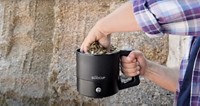Advertisement
Grab your lab coat. Let's get started
Welcome!
Welcome!
Create an account below to get 6 C&EN articles per month, receive newsletters and more - all free.
It seems this is your first time logging in online. Please enter the following information to continue.
As an ACS member you automatically get access to this site. All we need is few more details to create your reading experience.
Not you? Sign in with a different account.
Not you? Sign in with a different account.
ERROR 1
ERROR 1
ERROR 2
ERROR 2
ERROR 2
ERROR 2
ERROR 2
Password and Confirm password must match.
If you have an ACS member number, please enter it here so we can link this account to your membership. (optional)
ERROR 2
ACS values your privacy. By submitting your information, you are gaining access to C&EN and subscribing to our weekly newsletter. We use the information you provide to make your reading experience better, and we will never sell your data to third party members.
Analytical Chemistry
Raman Spots Hidden Danger
Method peers through opaque plastic containers to quickly probe for explosives
by Journal News and Community
October 17, 2011
| A version of this story appeared in
Volume 89, Issue 42
To airport security personnel, an opaque plastic bottle is a potential danger: Does it carry shampoo or explosives? Researchers in the Netherlands have now demonstrated that a Raman spectroscopy technique can detect and identify explosives hidden inside opaque plastic containers (Anal. Chem., DOI: 10.1021/ac2018102). Security personnel and emergency response teams often carry Raman-based handheld devices to quickly spot harmful materials in the field. But these devices struggle to collect spectra of chemicals concealed behind opaque plastic. Freek Ariese of Free University of Amsterdam and colleagues thought time-resolved Raman spectroscopy could peer past the plastic by closing the gate in front of the spectrometer’s detector for an instant after exciting a sample with a laser. With the gate closed, the researchers avoid signals from the plastic container. When the gate opens, the spectrometer collects photons from deep within the sample. Ariese’s team tested the method on a cuvette filled with dinitrotoluene, a by-product of TNT, located behind a variety of common white plastics up to 5 mm thick. Both the type of plastic and its thickness affected the optimum gating delay—between 300 and 500 picoseconds—but the researchers successfully detected the dinitrotoluene in each case.





Join the conversation
Contact the reporter
Submit a Letter to the Editor for publication
Engage with us on Twitter